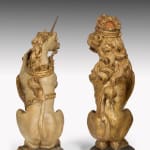James I Carved Oak Polychrome-decorated and Parcel-gilt Heraldic Supporters in the form of a Lion and a Unicorn
Height: 16 inches (40.5cm)
Width: 5.25 inches (13cm)
Depth: 8.25 inches (21cm)
Unicorn:
Height: 15.25 inches (39cm)
Width: 5.5 inches (14cm)
Depth: 8 inches (20cm)
Further images
A C14 CIRAM Scientific Report and dating test is available.
Careful Conservation removed multiple layers of later decoration to reveal the original decoration beneath.
In the form of a lion and a unicorn, supporters of the Royal Arms. The lion and the unicorn are symbols of the United Kingdom – taking the form of heraldic supporters. The lion symbolises England and the unicorn symbolises Scotland. This combination dates back to 1603, when King James VI of Scotland succeeded Elizabeth I when she died without children. Until this time the Scottish Royal Arms had used two unicorns as shield supporters; whilst the English Arms had used a variety of supporters, but had most frequently included a lion. James I placed a lion upon the left of the new Arms, and a unicorn upon the right. However, the rampant red lion had always been the primary symbol of Scotland.
Both supporters are modelled holding scroll-edged vacant shields and set on a domed base. The lion is depicted wearing a crown, standing erect with its forepaws raised – ‘rampant guardant dexter’. The unicorn is carved facing to the sinister and in the manner of the supporter to the Royal Arms, described by John Vinycomb as: ‘[a] unicorn argent, armed, unguled, crined and gorged or, with a royal coronet, having a chain affixed thereto, and reflexed over his back of the last.’ (John Vinycomb, ‘Fictitious and Symbolic Creatures in Art' (Evinity Publishing Inc, 2009), p.129). The term‘armed’ references the horn; ‘unguled’ references the hoofs; ‘crined’ references the flowing mane; and ‘gorged’ indicates that the coronet encircles the unicorn’s ‘gorge’ or throat. The term ‘or’ means the metal gold or the tincture of it.
The Stuart dynasty reigned in England and Scotland from 1603 until 1714. During the Jacobean period (the reign of James I) court culture and courtly patronage flourished. Great country houses were built by wealthy landed families – for example the Howards built Audley End and the Sackvilles constructed Knole – and skilled craftsmen were employed to work on elaborate decoration and ornamentation for these homes.
The ‘Sackville Leopards’ adorn the newel posts of the principal staircase at Knole, the home of the Sackvilles in Sevenoaks, Kent (now a National Trust property). The staircase was constructed between 1605 and 1608 during ‘re-edifying’ works undertaken by Thomas Sackville, 1st Earl of Dorset, and the leopards are derived from the Sackville coat of arms. There are interesting similarities in the scrolling of the shields, the angle of the animals’ heads, and the semi-spherical mound mounts which suggest that our lion and unicorn and the ‘Sackville Leopards’ may have been crafted by the same master craftsman or designer. The Sackvilles employed William Portington, the King’s Master Carver, and John Thorpe, the King’s Surveyor or Clerk of the Royal Works (who was also responsible for some of the panelling in the house) to work at Knole. John Thorpe also worked on Audley End in Essex, which was one of the houses built for the Howards in circa 1610. The Sackvilles and the Howards mixed in the same courtly circle and would have been very aware of their respective ambitious building projects.
The families who owned and built these great houses employed ‘painter-stainers’ who were responsible for embellishing the properties with elaborate decoration. Examples of decorative painters from this period were Paul Isaacson, who worked at Knole and Theobalds Palace; Ralph Treswell, who worked at Penshurst Place and Knole; and Serjeant-Painter John de Critz, who decorated Salisbury House in London. The layers of paint which were uncovered during the conservation work carried out on our lion and unicorn indicate that they were regularly re-painted, suggesting that they originated from either a royal residence or a stately home.
Heraldic beasts were used in many different interiors: country houses; townhouses; livery halls; boardrooms of various institutions; churches and places of worship; and warships. This pair of heraldic beasts may have been carved as newel post finials of a grand staircase – as demonstrated above; but it is possible that they may have been finials for a church or a livery hall. John Crowther (1837-1902)’s ‘Interior View of the Church of St Matthew, Friday Street’, a watercolour painted in 1881, demonstrates the use of such carvings within the interior of a church. Whilst the unicorn in the foreground is similar to ours, the layers of painted decoration suggest that our heraldic supporters were more likely to have come from a royal residence or a country house.
In 20th century Britain over 1,000 country houses were demolished. This phenomenon was brought about by a change in social, political and financial conditions – high taxation, death duties, and the loss of aristocratic heirs as well as workers to manage the estates following the two World Wars – which led to landed families selling estates and a large number of country houses being demolished. On 4 May 1912 ‘Country Life’ carried an advertisement for the ‘Stone Balustrade containing 140 turned balusters; 80 half-balusters; 13 massive pillars’ and ‘13 urns’ from Trentham Hall, Staffordshire, which were being sold for £200. This was a hint of things to come. In 1944 the trustees of Castle Howard began selling the contents of the house; the Duke of Bedford reduced Woburn Abbey to half its original size in 1947; and Alfred Waterhouse’s Eaton Hall was razed to the ground in 1963. From the turn of the 20th century, interior woodwork, including complete panelled rooms, staircases and fittings such as these heraldic beasts secured an active market amongst wealthy patrons from across the globe.






